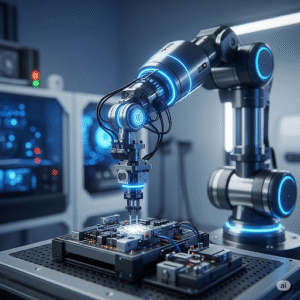Why Subsequent‑Gen Robotics Issues
🚀 Introduction: Why Subsequent‑Gen Robotics Issues
Welcome to an period the place robots aren’t simply machines—they’re clever companions. As we transfer via 2025 and past, robotics is present process a dramatic transformation. High-tier labs and corporations are pushing previous previous limits with applied sciences that mimic biology, combine superior AI, and reshape human interplay. From tender wriggle to ecosystem-scale swarms, this rising wave goals to revolutionize healthcare, manufacturing, supply, and even planetary exploration. Thrilling stuff, proper? Let’s dive in!
1. Comfortable Robotics & Versatile Actuation 🌀

What Are They?
Comfortable robotics are robots constructed with versatile supplies—assume silicone, gelatinous polymers, and even natural matter. These bots don’t simply transfer—they movement and conform.
Slicing-Edge Improvements
- Impressed by sea turtles, worms, and vine-like plant progress, these bots can stretch, crawl, and navigate tight environments with ease and charm.
- A latest January 2025 improvement launched a tender robotic able to speedy, highly effective joint movement—starting from delicate stroking (like brushing an egg) to crawling or leaping .
- Rising tender robots can elongate like vines, utilizing tip extension or additive materials deposition, enabling navigation via slender cavities or developing constructions in confined areas .
Actual-World Advantages
- Medical surgical procedure: Gentler robotic our bodies can navigate fragile tissues with minimal trauma.
- Environmental sensing: Comfortable sea-bots monitor reefs or polluted waters with out harming marine life.
- Search-and-rescue: Versatile bots can slip via particles or collapsed constructions to find survivors .
2. Self-Reconfiguring Modular Robots 🧩
Idea Overview
Think about robots fabricated from modular blocks that may rearrange themselves into new shapes on the fly—a bridge, a snake, or perhaps a spider robotic—all from the identical items .
How It Works
- Every module comprises sensors, reminiscence, energy provide, and actuator.
- Modules can dock or undock autonomously, reconfiguring in actual time.
- Helpful in environments the place adaptability, redundancy, and self-repair are crucial.
Use Instances
- House exploration: Robots that morph to deal with totally different terrains or assemble constructions on Mars.
- Rescue operations: Modules reassemble to navigate rubble or create short-term helps.
- Construct-on-demand objects: Partitions, bridges, or shelters that self-organize from modules.
3. Collaborative Robots (Cobots) & Cellular Manipulators (MoMas) 🤖🤝
Human‑Robotic Teamwork
Cobots are designed to work side-by-side with people with out obstacles. Geared up with sensor arrays and AI, they adapt to human rhythms and work safely in shared areas.
Introducing MoMas
Cellular manipulators mix autonomous navigation with a robotic arm. These robots transfer freely via warehouses or factories and carry out duties like choosing, inserting, or meeting—all with out human course .
Key Purposes
- Manufacturing strains: Cobots deal with exact, repetitive duties whereas people oversee extra advanced selections.
- Warehousing: MoMas fetch, kind, and ship parts autonomously.
- Healthcare logistics: Robots ship provides or medicines in hospitals, working seamlessly with workers.
4. Swarm Robotics & Collective Intelligence 🐜
Collective Conduct
Impressed by ants and bees, swarm robotics entails many easy robots working collectively to deal with duties that outsize any particular person bot.
Strengths
- Scalability: Extra robots = extra protection.
- Resilience: Failure of 1 bot doesn’t cease the mission.
- Flexibility: Suited to dynamic or unpredictable environments.
Typical Makes use of
- Search and rescue: Small bots swarm via collapsed buildings.
- Agricultural monitoring and harvesting: A number of bots share duties throughout fields.
- Swarm 3D printing: Microbots collaborate to assemble massive constructions layer by layer.
5. AI & Studying Techniques: Imaginative and prescient–Primarily based Self‑Management & Neuromorphic Intelligence 🧠

Imaginative and prescient–Primarily based Studying
MIT researchers have pioneered a system the place robots study to regulate their our bodies utilizing solely video—no costly sensors required. By observing their very own actions via cameras, robots derive a ‘visuomotor Jacobian’ that hyperlinks visuals to motor instructions.
Neuromorphic AI
This entails brain-inspired computing—spiking neural networks—enabling embodied, energy-efficient decision-making. Although early stage, neuromorphic robotics promise real-time adaptability, resilience, and even safety advantages.
Advantages
- Decrease price automation: fewer sensors, minimal calibration.
- Higher adaptability: robots can study from expertise, even in visible occlusion.
- Environment friendly, strong AI that mimics actual mind construction for embodied intelligence.
6. Fog Robotics & Edge Computing 🌫️
Hybrid Good Structure
Fog robotics pushes computation nearer to robots—bringing processing to native servers as an alternative of distant clouds. This reduces latency, bandwidth stress, and improves reliability in crucial duties.
Why It Issues
- Robots making split-second selections—like greedy or impediment avoidance—profit from near-instant processing.
- Coordinated groups of robots share information and compute outcomes rapidly.
- Privateness and safety are improved since delicate information stays native.
7. Biodegradable & Eco-Pleasant Robots ♻️
Sustainability in Design
New supplies make robots that may degrade naturally, particularly helpful for one-off or environmental deployments.
Purposes
- Monitoring ecosystems the place robotic retrieval is impractical.
- Environmental sampling or planting that leaves no hint.
- Momentary catastrophe robots that decompose after use.
8. Exoskeletons & Synthetic Muscle tissues 🦾
Enhanced Human Functionality
Wearable robotics—exoskeletons and tender exosuits—increase human power and mobility. They assist carry heavy masses, help with rehabilitation, or present mobility to impaired people.
Synthetic Muscle tissues
Mimicking organic muscle fibers, synthetic muscle tissues contract and chill out to ship exact, fluid movement. These are reworking prosthetics and fine-manipulation robotics in manufacturing or surgical procedure
9. Autonomous Supply Robots & Hybrid Drones ✈️🛴
On-Floor & in-Air Supply
Robots are reworking logistics—ground-based sidewalk robots and aerial drones now ship meals, packages, and provides reliably throughout cities.
Hybrid Robots
Some robots can transition between rolling alongside walkways and flying like drones—speedy, versatile, and splendid for last-mile supply in advanced city landscapes.
Key Gamers
- Serve Robotics and Coco Robotics function autonomous sidewalk bots in cities like Chicago and Los Angeles for meals supply.
- Drone providers like Wing and Zipline ship medical provides or meals utilizing superior GPS and sensors.
10. Medical & Surgical Robotics ⚕️
Precision Healthcare
AI‑powered robotic programs help surgeons with minimally invasive procedures, enhancing accuracy and decreasing restoration occasions.
Rehabilitation & Help
Robotic exosuits assist stroke survivors or mobility-impaired people regain motion. Diagnostic robots analyze scans, enabling early detection and higher outcomes.
Hospital Automation
Robots more and more deal with deliveries, sanitation, and affected person interplay—boosting effectivity and hygiene in crucial healthcare infrastructure.
11. Humanoid Robots: The Way forward for Private and Industrial Assistants
What’s New in 2025?
Humanoid robots are rising much more succesful. Enhanced dexterity, mobility, and emotional intelligence allow them to help in caregiving, hospitality, factories, and houses.
Trade Momentum
- Nvidia and OpenAI predict humanoid robots turning into widespread by 2027, because of superior AI and simulation information enabling actual‑world deployment.
- In South Korea, the brand new Ok-Humanoid Alliance (launched April 2025) brings collectively business, academia, and state assist to speed up humanoid analysis and commercialization.
- Unitree Robotics in China is testing its G1 humanoid in industrial contexts and gearing up for an IPO late in 2025.

12. Different Rising Developments
AI‑Pushed Predictive Upkeep
Robots self-monitor with embedded sensors and machine studying to foretell failures earlier than they occur—maintaining manufacturing flowing and saving prices.
Human‑Robotic Interplay Upgrades
Advances in pure language, gesture detection, and facial recognition allow smoother communication—robots now choose up verbal and non‑verbal cues in buyer‑service roles or healthcare settings.
Web of Robotic Issues (IoRT)
Networks of robots share sensor information, coordinate duties, and optimize workflows throughout factories and farms. IoRT fosters seamless robotic ecosystems that assume collectively as an alternative of alone.
Robotic Cybersecurity
As robots handle crucial duties, defending them from hacking turns into essential. Rising protocols guarantee information integrity, protected operation, and belief in robotic programs.
🌐 World Context & Social Influence
- In Japan, alarmingly low beginning charges are driving adoption of automation in care, agriculture, retail, and logistics to counter labor shortages.
- Training: Faculties worldwide are instructing robotics as core topics—college students are designing rescue bots in competitions and receiving real-world publicity early on.
- Trade shifts: India and South Korea are launching initiatives to embed robotics coaching into curricula, guaranteeing the long run workforce is prepared for robotic collaboration.
📊 Abstract Desk of Key Applied sciences
| Know-how | Core Strengths | Instance Use Instances |
|---|---|---|
| Comfortable Robotics & Versatile Actuators | Security, adaptability, mild dealing with | Surgical procedure, reef monitoring, rescue operations |
| Self‑Reconfiguring Modular Robots | Morphing form, redundancy, multi‑process versatility | House missions, autonomous development |
| Collaborative & Cellular Robots (Cobots & MoMas) | Human teaming, cell attain | Warehousing, manufacturing, healthcare logistics |
| Swarm Robotics | Scale, resilience, coordination | Agriculture, search‑rescue, structural printing |
| Imaginative and prescient–Primarily based AI & Neuromorphic Studying | Low-cost adaptability, embodied intelligence | Autonomous arms, adaptive robots |
| Fog Robotics & Edge AI | Pace, privateness, actual‑time response | On-site robotics networks |
| Biodegradable & Eco‑Pleasant Robotics | Sustainable, single-use functions | Environmental monitoring, catastrophe response |
| Exoskeletons & Synthetic Muscle tissues | Energy augmentation, mobility support, fantastic manipulation | Rehabilitation, industrial lifting, prosthetics |
| Supply Robots & Hybrid Drones | Pace, contactless supply, city adaptability | Meals, medical, parcel supply |
| Humanoid Robots | Social interplay, general-purpose help | Companionship, service, manufacturing facility help |
✨ Remaining Ideas
The following era of robotics shouldn’t be about including extra steel arms—it’s about mixing biology-inspired design, embodied intelligence, and human-friendly interfaces. From tender, versatile “creatures” that mimic nature to modular robots that reconfigure on demand; from swarming bots that deal with large-scale challenges to humanoid robots that may stroll into our properties by 2027—it’s an exciting, transformative journey.
This convergence of AI, supplies science, edge computing, and robotics guarantees not simply extra environment friendly machines, however smarter, safer, and extra sustainable companions in practically each business. As we embrace these instruments, we additionally face challenges—moral design, regulation, cybersecurity, fairness in entry—however the potential for constructive societal affect is big.
Able to study extra a few particular space—say, swarm drones, exosuits, or the newest Unitree humanoid? I’d like to dive deeper! 🤖💡

